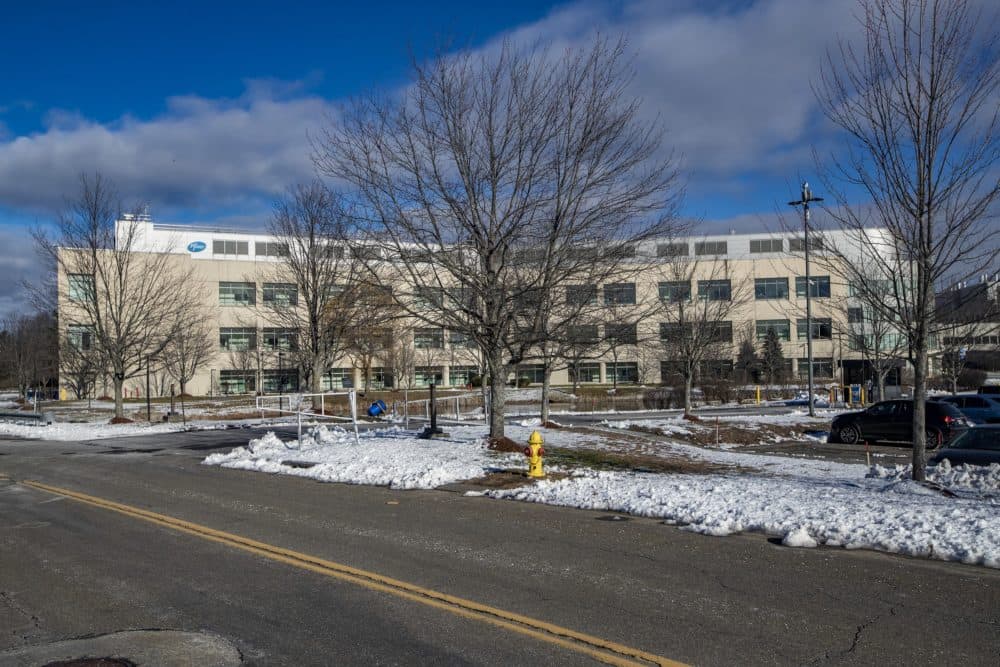Advertisement
Coronavirus Coverage
Pfizer Is Already Producing Millions Of Doses Of Its Vaccine. A Crucial Ingredient Comes From Mass.

With its glittering glass façade reflecting the woods, Pfizer’s facility in Andover looks more like a university science center than a major manufacturing site. But inside are large, stainless steel tanks serving as chemical reactors for the company to produce the core component of its coronavirus vaccine – the RNA.
“It’s kind of the main ingredient,” explains Meg Ruesch, Pfizer’s vice president of research and development. “The RNA is the part of the vaccine that provides genetic instructions to the cells.”
Like DNA, RNA carries genetic information that cells use to build proteins. The RNA in Pfizer’s vaccine instructs cells to construct the coronavirus’s spike protein, the weapon the virus uses to attack and infect cells. If all goes well, the immune system then rushes to create defenses that can neutralize that weapon, and thus the virus, should you become exposed.
Every Pfizer vaccine needs a copy of this RNA, so Ruesch’s team is hustling to make hundreds of millions of them.
“We have people really putting in a ton of extra hours and doing a lot of extra weekend work and things like that,” Ruesch says.
Typically, Pfizer uses this facility to research how to manufacture new drugs and produce them for clinical trials. Ruesch says this made it the right facility to manufacture the key part of an experimental vaccine.
“We are used to working on new drugs that are critical for patients in all sorts of areas,” she says. “I think the unusual part here is just the scale of it – how much we’re ready to make of the vaccine.”
Pfizer originally hoped to produce 100 million doses of the new coronavirus vaccine by the end of 2020, but now estimates it will have half that number ready. The company says it is still on track to produce over 1 billion doses by the end of 2021, partially because Pfizer put some $2 billion dollars into the vaccine’s development last spring.
Back then, it was still unclear how well this vaccine would work or if it would be safe. If the vaccine’s clinical trials failed, the money, time and potentially millions of finished vaccines would go to waste.
Advertisement
“But, you know, global pandemic,” Ruesch says with a laugh. “So, the corporation definitely thought it was worth spending this money at risk.”
The investment might very well pay off. Ruesch says that money helped stockpile raw materials, and allowed the company to move with lightning speed to get a vaccine through three clinical trials and to the Food and Drug Administration’s doorstep in record time. Regulators will meet to discuss an emergency authorization tomorrow, less than a year after Ruesch’s team first began developing the vaccine. An FDA analysis of the clinical data found the vaccine is safe and highly effective.
“That’s very good news,” says Dr. Philip Landrigan, an epidemiologist at Boston College who wasn’t involved with Pfizer’s work. “It’s not the end of the COVID story, but it’s the beginning of the end.”
There are still hurdles that Pfizer will need to overcome, Landrigan says. One that’s generated a lot of concern is the vaccine’s extreme cold storage requirement. It must be kept at negative 80 degrees Celsius.
“Which is equivalent to temperatures found on Antarctica,” says Timothy Springer, an immunologist at Harvard Medical School and co-founder of Moderna, the Cambridge biotech that applied for emergency authorization for its own coronavirus vaccine last week. “Our distribution systems for medicine just never ship at that temperature.”
Only super cold freezers can maintain the necessary temperatures. That will make Pfizer's vaccine more difficult to distribute, particularly in rural areas away from large urban centers and major hospitals. Even so, the vaccine may be instrumental in helping end the COVID-19 pandemic. It’s already being distributed in the United Kingdom, which approved the vaccine last week, and may begin to be administered in the U.S. before the end of this month.
Knowing that makes the late nights and hard work worth it, Ruesch says.
“Helping the world – maybe helping save the global economy,” She says. “It's an honor. I’m proud to be doing what we’re doing.”
This segment aired on December 9, 2020.
